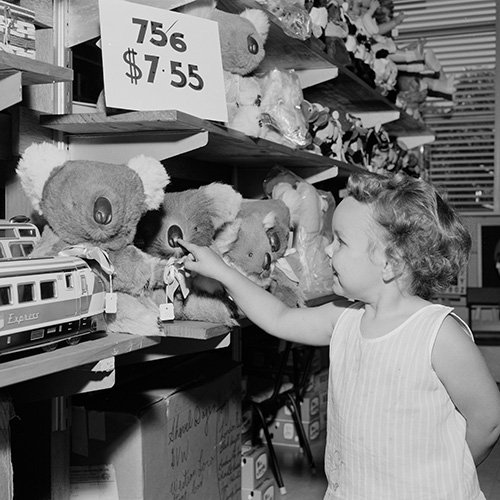On this day: Australia switches from pounds to dollars

ON THE MORNING of 14 February 1966, Australia’s shops, banks and ticket offices opened their doors and ushered in the age of decimal currency. Curious citizens formed long queues to exchange their pounds and pennies for brand-new dollars and cents.
Changeover Day, or ‘C-Day’, went off without a hitch The Sydney Morning Herald reported; “The smoothness of the change, the efficiency of business people and the good humour of the public delighted Decimal Currency Board officials”. Perhaps the biggest hiccup came with six-year-old Kim Taylor, who became the first Australian child to swallow a decimal coin.
The decision to change from the awkward and unwieldy system of pounds, shillings and pennies had been a long-time coming. The idea of a decimal currency – that is, a system based on the number 10 – had been brewing for over 100 years, but Mother England put her foot down: pounds and the base-12 system were a proud tradition.
That is, until Robert Menzies made an election promise in 1958 to seriously consider decimalisation. The argument for switching was simple: under the Imperial system, one Australian pound was divided into 20 shillings, which in turn was comprised of 12 pence each. This made financial transactions slower and more complicated.
“The economic benefits had become undeniable,” says Peter Rees, author of Inside the Vault: The History and Art of Australian Coinage. “It would be simpler for Australian trade. There were only a handful of non-decimal countries, so it made sense economically.”
It would also make the everyday shoppers’ life substantially easier. Remember, this was before tills could add up for you, so all addition had to be figured out mentally. Give it a go: let’s say you are buying four pounds of potatoes, which cost three shillings and 11 pence per pound. How much do you pay in total? You probably need a pen and paper to figure this out (the answer is 15 shillings and eight pence).

Both currencies could be used during the transition period; here, the cost of the soft toy is shown in both dollars and shillings. (Credit: National Archives of Australia)
Royal vs. dollar: a naming controversy
The only argument for actually keeping the pound centred on the nation’s symbolic kinship with Britain. Menzies, a staunch monarchist, had a solution: he believed the new currency should be named the ‘royal’.
The Currency Act 1963 set ‘C-Day’ for 14 February 1966, followed by a two year transition period where both pounds and dollars could be used. A competition to crowdsource a name for the new currency was launched, attracting thousands of creative suggestions. Neither ‘Coiny McCoinface’ nor ‘Dollarydoos’ were submitted, but the suggestions did encompass some quintessential Australiana: Boomer, Roo, Digger, Oz, Austral, Kanga, Dinkum and even Ming (Menzies’ nickname).
Menzies overruled these ideas in favour of ‘royal’, to the great dismay of the public. His choice proved so overwhelmingly unpopular that the Government had to backtrack a few months later. “The correspondence of politicians at the time shows they were horrified at the backlash,” says Peter. Indeed, then-treasurer Harold Holt called it “a terrible mistake”. The name ‘dollar’ was chosen instead – a great relief for the Australian people.
Coins and banknotes for a new Australia
New notes and coins were designed. Coins featured Australian wildlife, while notes reflected Australia’s history and contributions to the world. In preparation for the big switch, a stockpile of one billion coins was minted and transported all over Australia by police-escorted trucks in ‘Operation Fastbuck’. Bank machinery, parking meters, cash registers and petrol pumps all had to be converted.
Meanwhile, a large-scale public awareness campaign brought cartoon Dollar Bill to the fore of every Australian’s mind. With a catchy jingle based on ‘Click go the shears’, Dollar Bill reassured and educated the masses about the incoming decimal system. The campaign worked a charm, according to Peter, “There wasn’t really any resistance. People took to it very quickly and there was a general air of optimism and positivity”.
The cartoon character Dollar Bill helped Australians learn about the new decimal system. (Credit: NFSA Films/YouTube)
Throughout the two-year phasing-out period, citizens could use either the old or new currency to pay for goods and services, and any change they received would be dollars and cents. A conversion rate was set: £1 was equivalent to $2. The Reserve Bank gradually withdrew the old money, while some of the old coins were recycled to make new ones by the Royal Australian Mint.
The adoption of a decimal currency was about more than just finances – it also reflected Australia’s developing identity. “The change evoked the spirit of the 60s and the self-confidence of emerging post-war Australia,” says Peter. “The designs captured Australia’s imagination and reflected a growing awareness that we had our own interesting wildlife and history.”
After C-Day, Australia’s logistical and PR success in decimalisation had far-reaching effects. “The changeover was so successful that Australia’s preparation efforts formed the basis of public education campaigns in Britain and New Zealand, who had also been flirting with the idea of decimalisation,” explains Peter. It also paved the way for metrification in the 1970s – that is, the official conversion of measurements from the imperial system (ounces, inches) to the metric system (grams, metres).
There is perhaps only one loss resulting from this momentous day: the coin in the Christmas pudding. It was a long-standing tradition to bake a silver coin into the pudding, which brought luck to whoever found it in their serving. Cooking the new-fangled coins turned them a ghastly green, thanks to their copper and nickel content.
READ MORE:




